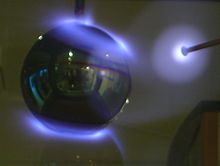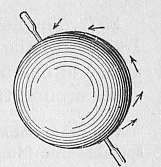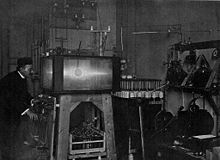32:
20:
145:
232:
Recently the terrella experiments have been further developed by a team of physicists at the
Institute of Planetology and Astrophysics in Grenoble, France to create the "planeterrella" which uses two magnetised spheres which can be manipulated to recreate several different auroral phenomena.
224:
conducted more realistic experiments around 1990. All such experiments are difficult to interpret, and are never able to scale all the parameters needed to properly simulate the Earth's magnetosphere, which is why such experiments have now been completely replaced by
170:) at a terrella in a vacuum tank, and found they indeed produced a glow in regions around the poles of the terrella. Because of residual gas in the chamber, the glow also outlined the path of the particles. Neither he nor his associate
132:, balanced on a horizontal axis perpendicular to the magnetic one, indicated the proper "magnetic inclination" between the magnetic force and the horizontal direction. Gilbert later reported his findings in
205:(1788–1869) also experimented with a terrella. He used an electromagnet, placed within a large hollow iron sphere, and this was examined in the darkroom under varying degrees of electrification.
124:
William
Gilbert's explanation was that the Earth itself was a giant magnet, and he demonstrated this by creating a scale model of the magnetic Earth, a "terrella", a sphere formed out of a
148:
Kristian
Birkeland and his magnetized terrella experiment, which led him to surmise that charged particles interacting with the Earth's magnetic field were the cause of the aurora.
87:
174:(who calculated such paths) could understand why the actual aurora avoided the area directly above the poles themselves. Birkeland believed the electrons came from the
128:. Passing a small compass over the terrella, Gilbert demonstrated that a horizontal compass would point towards the magnetic pole, while a
23:
Kristian
Birkeland's magnetised terrella. In this experiment, he noted two spirals which he considered may be similar to that of
221:
358:
212:, around 1950, used a terrella to simulate trajectories of particles in the Earth's field. Podgorny in the
94:
56:
98:
106:
185:
Birkeland constructed several terrellas. One large terrella experiment was reconstructed in
300:
114:
8:
274:
226:
156:
343:
74:
Terrellas have been used until the late 20th century to attempt to simulate the Earth's
152:
64:
102:
31:
217:
202:
155:
was a
Norwegian physicist who, around 1895, tried to explain why the lights of the
19:
171:
63:, and further developed 300 years later by the Norwegian scientist and explorer
44:
121:
showed the force on the needle was not horizontal but slanted into the Earth.
352:
118:
75:
24:
213:
68:
284:
163:
326:
133:
129:
105:, devoted much of his time, energy and resources to the study of the
280:
144:
125:
60:
186:
167:
179:
134:
De
Magnete, Magneticisque Corporibus, et de Magno Magnete Tellure
110:
55:, that is thought to have been invented by the English physician
220:
was directed, simulating the solar wind. Hafiz-Ur Rahman at the
209:
190:
86:
48:
117:) found that direction deviated somewhat from true north, and
52:
109:. It had been known for centuries that a freely suspended
175:
159:
appeared only in regions centered at the magnetic poles.
113:
needle pointed north. Earlier investigators (including
78:, but have now been replaced by computer simulations.
178:, since large auroral outbursts were associated with
216:, around 1972, built terrellas at which a flow of
276:The Norwegian Aurora Polaris Expedition 1902-1903
350:
139:
272:
81:
298:
16:Device that simulates Earth's magnetic field
279:. New York and Christiania (now Oslo): H.
344:NASA Educational Website on the Terrella
143:
85:
30:
18:
47:for 'little earth') is a small
351:
268:
266:
162:He simulated the effect by directing
263:
222:University of California, Riverside
13:
196:
14:
370:
337:
273:Birkeland, Kristian (1908–1913).
35:An example of an active terrella
319:
292:
289:out-of-print, full text online
243:
1:
256:
249:Section 2, Chapter VI, p. 678
140:Kristian Birkeland's terrella
51:model ball representing the
7:
327:"Planeteterrella - English"
10:
375:
90:William Gilbert's terrella
82:William Gilbert's terrella
67:, while investigating the
301:"The Birkeland Terrella"
236:
208:Brunberg and Dattner in
149:
91:
36:
28:
283:& Co – via
166:(later identified as
147:
136:, published in 1600.
89:
34:
22:
227:computer simulations
115:Christopher Columbus
59:while investigating
359:Physics experiments
299:Terje Brundtland.
153:Kristian Birkeland
150:
92:
65:Kristian Birkeland
37:
29:
201:The German Baron
107:Earth's magnetism
103:Queen Elizabeth I
366:
331:
330:
323:
317:
316:
314:
312:
296:
290:
288:
270:
250:
247:
203:Carl Reichenbach
374:
373:
369:
368:
367:
365:
364:
363:
349:
348:
340:
335:
334:
325:
324:
320:
310:
308:
297:
293:
271:
264:
259:
254:
253:
248:
244:
239:
199:
197:Other terrellas
142:
99:royal physician
95:William Gilbert
84:
57:William Gilbert
17:
12:
11:
5:
372:
362:
361:
347:
346:
339:
338:External links
336:
333:
332:
318:
291:
261:
260:
258:
255:
252:
251:
241:
240:
238:
235:
198:
195:
141:
138:
83:
80:
25:spiral nebulae
15:
9:
6:
4:
3:
2:
371:
360:
357:
356:
354:
345:
342:
341:
328:
322:
306:
302:
295:
286:
282:
278:
277:
269:
267:
262:
246:
242:
234:
230:
228:
223:
219:
215:
211:
206:
204:
194:
192:
188:
183:
181:
177:
173:
169:
165:
160:
158:
154:
146:
137:
135:
131:
127:
122:
120:
119:Robert Norman
116:
112:
108:
104:
100:
96:
88:
79:
77:
76:magnetosphere
72:
70:
66:
62:
58:
54:
50:
46:
42:
33:
26:
21:
321:
309:. Retrieved
304:
294:
275:
245:
231:
214:Soviet Union
207:
200:
184:
172:Carl Størmer
164:cathode rays
161:
157:polar aurora
151:
123:
93:
73:
40:
38:
285:archive.org
257:References
182:activity.
130:dip needle
49:magnetised
281:Aschehoug
168:electrons
126:lodestone
61:magnetism
353:Category
41:terrella
180:sunspot
111:compass
311:24 May
305:Sphæra
218:plasma
210:Sweden
191:Norway
187:Tromsø
97:, the
69:aurora
237:Notes
53:Earth
45:Latin
313:2012
307:(7)
176:Sun
101:to
355::
303:.
265:^
229:.
193:.
189:,
71:.
39:A
329:.
315:.
287:.
43:(
27:.
Text is available under the Creative Commons Attribution-ShareAlike License. Additional terms may apply.



